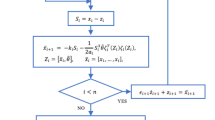Abstract
This article presents a methodology for compensating for the time-delay effects in tele-operated control systems. Compensation can be carried out by a neural network. A tele-operated system consists of a master robot to give commands, and a slave robot to work with the environment. The positional command by the master robot is transferred to the slave robot, and the contact force from the environment is transferred back to the master robot. The structure of the Smith predictor is modified by replacing the linear estimator with a neural network whose structure is based on the radial basis function (RBF). The RBF network identifies the slave model to deal with the nonlinearities in the system. Simulation studies have been conducted, and experimental studies of one-directional force control were performed to confirm the simulation results.
Similar content being viewed by others
Explore related subjects
Discover the latest articles, news and stories from top researchers in related subjects.References
Anderson RJ, Spong MW (1989) Bilateral control of teleoperators with time delay. IEEE Trans Autom Control 34(5):494–501
Lawn CA, Hannaford B (1993) Performance testing of passive communication and control in teleoperation with time delay. Conference on Robotics and Automation vol. 3, IEEE, pp 776–783
Dubey R, Chan TF, Everett SE (1997) Variable damping impedance control of a bilateral telerobotic system. IEEE Control Syst Mag 17(1):37–45
Yokokohji Y, Imaida T, Yoshikawa T (2000) Bilateral control with energy balance monitoring under time-varying communication delay. IEEE Conference on Robotics and Automation, pp 2684–2689
Zhu WH, Sacudean SE (2000) Stability guaranteed teleoperation: an adaptive motion/force control approach. IEEE Trans Autom Control 45(11):1951–1969
Arioui H, Mammar S, Hamel T (2002) A Smith-prediction-based haptic feedback controller for time delayed virtual environment systems. American Control Conference, pp 4303–4308
Arioui H, Mana M, Kheddar A, et al (2002) Master-model-based time-delayed force feedback interaction experimental results. IEEE Symposium on Intelligent Control, pp 896–901
Palafox OM, Lee DJ, Spong MW, et al (2006) Bilateral teleoperation of mobile robot over delayed communication network: implementation. IEEE IROS pp 4193–4198
Miall RC, Weir DJ, Wolpert DM, et al (1993) Is the cerebellum a Smith predictor? J Motor Behav 25(3):203–216
Sugi T, Nakamura M, Ide J, et al (2003) Modeling of motor control on manual tracking for developing a hand movementcompensation technique. Artif Life Robotics 7: 112–117
Rahman AA, Natori K, Ohnishi K (2009) Disturbance decomposition of time delay system by shadow robot based on network disturbance concept. IEEE International Conference on Industrial Technology, pp 1120–1125
Tan Y, Cauwenberghe AV (1994) Nonlinear neural controller with neural Smith predictor. Neural Process Lett 1(2):24–27
Smith AC, Hashtrudi-Zaad K (2006) Smith predictor-type control architectures for time-delayed teleoperation. Int J Robotics Res 25(8):797–818
Author information
Authors and Affiliations
Corresponding author
Additional information
This work was presented in part at the 14th International Symposium on Artificial Life and Robotics, Oita, Japan, February 5–7, 2009
About this article
Cite this article
Choi, H.J., Jung, S. Neural network-based Smith predictor design for the time-delay in a tele-operated control system. Artif Life Robotics 14, 578–583 (2009). https://doi.org/10.1007/s10015-009-0750-6
Received:
Accepted:
Published:
Issue Date:
DOI: https://doi.org/10.1007/s10015-009-0750-6




